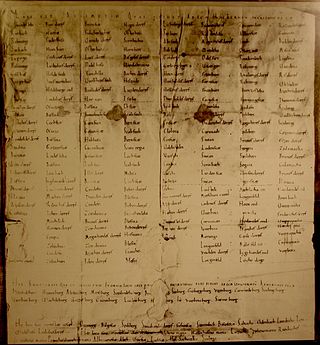
Georg August Goldfuß was a German palaeontologist, zoologist and botanist. He became a professor of zoology at the University of Erlangen and later at the University of Bonn. He coined the terms "protozoa" and "pelecypoda".
August Meitzen was a German statistician.

Eastphalia is a historical region in northern Germany, encompassing the eastern Gaue (shires) of the historic stem duchy of Saxony, roughly confined by the River Leine in the west and the Elbe and Saale in the east. The territory corresponds with modern southeastern Lower Saxony, western Saxony-Anhalt, and northern Thuringia. Together with Westphalia, central Angria, and Nordalbingia, it was one of the four main Saxon administrative regions.

Eduard von Martens also known as Carl or Karl Eduard von Martens, was a German zoologist.

Memleben Abbey was a Benedictine monastery in Memleben on the Unstrut river, today part of the Kaiserpfalz municipality in Saxony-Anhalt, Germany. The convent, now ruined, was established by Emperor Otto II and his consort Theophanu about 979.

Gardeja is a village in Kwidzyn County, Pomeranian Voivodeship, in northern Poland. It is the seat of the gmina called Gmina Gardeja. It had been a town during the time span 1334–1945.

Esperstedt is a village and a former municipality in the Saalekreis district, Saxony-Anhalt, Germany. Since 1 January 2010, it is part of the municipality Obhausen.

The Hassegau was a medieval shire (Gau) in the Eastphalia region of the Duchy of Saxony. It was located in the duchy's southeastern corner; confined by the Saale river to the east and its Unstrut and Wipper tributaries to the south and north. Its most important town was Merseburg. In present-day borders, it is in the southeastern part of Saxony-Anhalt.
Heinrich Friedrich Franz Körte was a German natural and agricultural scientist, and for thirty years Professor of Natural Sciences at the Agricultural Academy in Möglin, which was founded by Albrecht Daniel Thaer.
Isaac de Forcade de Biaix, aka Isaak de Forcade de Biaix, aka Isaac von Forcade de Biaix, aka Isaac von Forcade, aka Peter Isaac von Forcade, aka Isaak von Forcade, was a Royal Prussian colonel, Hofmarschall to the Prince of Prussia and recipient of Prussia's highest military order of merit for heroism, Knight of the Order of Pour le Mérite. He was a descendant of the noble family of Forcade in Béarn, born as a Roman Catholic, but emigrated to Brandenburg-Prussia at a young age, where he joined the Huguenot community in Berlin.
Friedrich Wilhelm Leopold Konstantin Quirin Freiherr von Forcade de Biaix, aka Friedrich Wilhelm Leopold Konstantin Quirin von Forcade de Biaix, Herr of Schleibitz, Hamm, Groß-Naedlitz and Loslau, aka the Baron von Forcade,, Royal Prussian Major, Knight of the Iron Cross 2nd Class on 26 August 1813, knighted by His Majesty Frederick William III of Prussia as Knight of the Order of Saint John in 1817, Royal Prussian Chamberlain (Kammerherr) and Castellan (Drost) of Neuenrade in the County of Mark, after his father's death in 1808. He was also a publisher, author, and theater director.
Friedrich Wilhelm von Forcade de Biaix, aka Frideric Guillaume de Forcade was a Royal Prussian Colonel, Schwadronschef of the 2nd Grenadier Company in the 24th Prussian Infantry Regiment, recipient of the Kingdom of Prussia's highest military order of merit for heroism, Knight of the Order of Pour le Mérite (1774), Commandant of Frankfurt/Oder, and Presbyter of the French congregation of Frankfurt/Oder.
Friedrich Wilhelm Ferdinand Ernst Heinrich von Forcade de Biaix, aka Ferdinand von Forcade, Royal Prussian Major and Knight of the Iron Cross 2nd Class.
Johann Christian von Hellbach 15 July 1757 – 18 October 1828) was a German lawyer and writer. He wrote extensively but not exclusively on history.
The Ahrgau was a medieval Frankish gau that lay either side of the River Ahr in the north of the present-day German state of Rhineland-Palatinate, but also reached the gates of Bonn, especially after the dissolution of the Odangau.

The Gau Essen was an administrative division of Nazi Germany from 1933 to 1945 in the northern parts of the Prussian Rhine Province. Before that, from 1928 to 1933, it was the regional subdivision of the Nazi Party in that area.
The Deutsches Archiv für Erforschung des Mittelalters is a historical journal on history between 400 CE and 1500 CE, published by the Monumenta Germaniae Historica (MGH), the German institute for study of the Middle Ages. It numbers its volumes from 1937, named the Deutsches Archiv für Geschichte des Mittelalters from volume 7 (1944). Its forerunners were the twelve-volume 1820-1874 Archiv der Gesellschaft für ältere deutsche Geschichtskunde and the fifty-volume 1876-1935 Neues Archiv der Gesellschaft für ältere deutsche Geschichtskunde. It has been published in Weimar then Cologne by Böhlau Verlag, its current publisher, and is the oldest German-language journal on medieval history.

The Hersfeld Tithe Register is a list of the places and castles in the Friesenfeld Gau (territory) and in Hassegau, from which Hersfeld Abbey received tithes. The original document dates from between 881 and 887 or between 896 and 899, but no longer exists. The list is found in a transcript from the 11th Century, which is now in the Hessischen Staatsarchiv Marburg.

The Groß Wartenberg district, known until 1888 as the Wartenberg district, was a Prussian district in Silesia from 1742 to 1945. Its capital was the town of Groß Wartenberg (Syców), which was known until 1888 as Polnisch Wartenberg. The area of this district now lies within the Lower Silesian Voivodeship of Poland.
A mining district in the European context denotes a specific geographically-defined area under the control and administration of a single mining authority. This district includes the mines, saltworks and smelters located within it.









